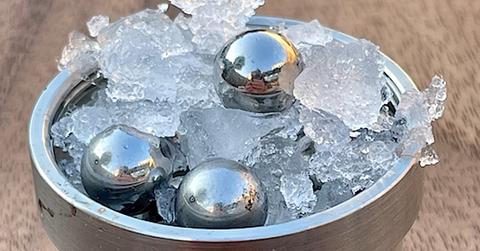Scientists Discover New Form of Ice, Which Could "Finally Explain Liquid Water"
Published Feb. 6 2023, 12:19 p.m. ET

Part of the set-up for creating medium-density amorphous ice
There's officially a cooler way to order a martini than "shaken, not stirred" — and it's with the new form of ice that scientists just discovered.
To be more specific, it's actually a new form of amorphous ice, a type of ice that is rarely naturally found on Earth, due to its unusual arrangement of atoms. However, humans can pretty easily create the new form of amorphous ice using nothing but water and, oddly enough, silver balls.
“We have shown it is possible to create what looks like a stop-motion kind of water," co-author Professor Andrea Sella stated. "This is an unexpected and quite amazing finding.”
Keep reading to learn all about this unique new ice form.

Part of the set-up for creating medium-density amorphous ice
A new form of ice, called medium-density amorphous ice, has been discovered via ball milling.
On Feb. 2, 2023, researchers from University College London and the University of Cambridge announced the findings of their new study, which was published in the journal Science.
According to a press release posted by University College London, the newly discovered ice is amorphous, meaning "its molecules are in a disorganized form, not neatly ordered as they are in ordinary, crystalline ice."
The scientists are calling it "medium-density amorphous ice" (MDA), and noted that it resembles a fine white powder. (The photos shared in the press release and this article are of ice before it was shaken and turned into MDA.)
The researchers discovered this ice form via a process called "ball milling," which involves "vigorously shaking ordinary ice together with steel balls in a jar cooled to -200 degrees [Celsius]" for a long time. This process has never been applied to ice before, and the team was surprised to find that ball milling actually "destroyed the crystal structure," resulting in MDA.
They also explained that amorphous ice is rare on our home planet, but it is actually the dominant ice form in outer space. "That is because in the colder environment of space, ice does not have enough thermal energy to form crystals," they wrote.
Medium-density amorphous ice can teach us a lot about water, the solar system, and more.
Though this is the first time this exact form of MDA has been discovered on Earth, the researchers believe it might exist in outer space — specifically, on ice moons in the outer solar system. This is because, as the researchers hypothesize, Jupiter and Saturn's tidal forces may apply a force on ice similar to the force created by ball milling.
Also, the researchers found that heating up and then recrystallizing MDA emits a lot of heat, which could set off events such as “icequakes” in the very thick outer icy later on moons.
Previously, only two forms of amorphous ice have been identified: high-density amorphous ice and low-density amorphous ice.
"There is a huge density gap between them and the accepted wisdom has been that no ice exists within that density gap," senior author, Professor Christoph Salzmann, said in a statement. "Our study shows that the density of MDA is precisely within this density gap and this finding may have far-reaching consequences for our understanding of liquid water and its many anomalies.”
Salzmann believes that the findings of the new study means that existing water models must be re-tested, to help explain the existence of MDA. "This could be the starting point for finally explaining liquid water," he stated.
Overall, the team believes that this discovery could lead to many other discoveries regarding water, ice, and various parts of outer space.